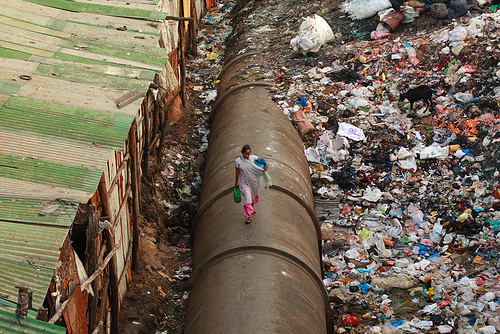 Woman carrying water through the Dharavi slum of Mumbai.Photo: Meena KadriCross-posted from Cool Green Science.
Woman carrying water through the Dharavi slum of Mumbai.Photo: Meena KadriCross-posted from Cool Green Science.
Imagine living on less than a bathtub of water for all your daily needs: drinking, cooking, bathing, washing clothes … and everything else.
By 2050, more than 1 billion city dwellers may be doing just that if we don’t build new infrastructure or begin new water conservation efforts, according to a new study [PDF] by scientists at The Nature Conservancy and other institutions.
And more than 3 billion in cities may suffer similar water shortages at least one month of every year, says the report. The drivers will be urban demographics and climate change — and the shortages are projected to hit megacities on every continent, from Manila to Johannesburg to Mumbai to Mexico City.
The minimum amount of water the study assumes every person needs daily is minuscule: Less than 100 liters — about 2/3 of a bathtub — for all a person’s daily needs. (The average U.S. resident uses 2-5 times that much.)
Rob McDonald, Nature Conservancy scientist and lead author of the study, says there’s still time to take action against these shortages — but we can’t just build more infrastructure to make it work. I asked him to go deeper into the numbers and the potential solutions.
 Scientist Robert McDonald.Q. First, where did you get the 100 liters number from? And have you ever tried to live on 2/3 of a bathtub of water a day? What’s it like?
Scientist Robert McDonald.Q. First, where did you get the 100 liters number from? And have you ever tried to live on 2/3 of a bathtub of water a day? What’s it like?
A. The 100 liters threshold is from the World Health Organization, which has said that’s the minimum amount of water needed to maintain “optimum” health long-term. Of course, people in dire situations can survive on much less.
After this paper came out, I tracked my family’s use of water for a week — we average out to around 130 liters/person/day, so a bit above the threshold we used in the paper.
Doing that did help me identify some quick ways I could save water. I have an old house, and I probably just need to install some low-flow faucet aerators. Right now some of my faucets don’t have any aerators, so it turns out I’m wasting a lot of water! I also have old clothes-washing and dish-washing machines. I’m too cheap to change those right away, but once they break I’m now motivated to replace them with low-flow machines. If I did that, we’d be below 2/3 of a bathtub of water a day.
Q. The study says we can’t just build our way out of this crisis with more pipes and aqueducts. Why not? What are the alternatives?
A. Well, cities commonly transport water longer distances to get around water shortages, and that other strategies include desalinization or unsustainably pumping groundwater. But the problem with all of these strategies is that they cost money. One study estimated that the world will have to spend $180 billion a year to meet its urban water needs.
Whatever the real figure is, there’s a serious issue here the world needs to pay attention to. In this paper, we are showing the scope of that problem, and trying to remind planners that there are more ways to solve the problem than just building more dams.
Urban water managers and city planners should look at solutions that involve nature as well as more infrastructure. One solution: more efficient water use by agriculture and industry — two of the biggest users of water worldwide. Payments to farmers to reduce areas of irrigated agriculture might be another partial solution, as well as removal of non-native water-hungry vegetation such as eucalyptus.
Q. The first response that often comes up to studies involving population is “Isn’t this just a matter of overpopulation? People should stop having babies, and that will solve the problem.” How do you respond to that line of thinking?
A. It’s just a really simplistic way to look at a very complex issue, and kind of a cruel way. Having children is one of the most important, life-defining experiences for most people, and many people would argue it’s a basic human right.
You have to look at population growth in the full context of what’s called the demographic transition. In very poor countries, the birth rate is high, but so is the death rate. As countries economically develop, there is a tendency for the death rate to fall first, as very basic sanitation measures are implemented. Then, at slightly higher economic levels of development, the birth rate falls too.
If you look at where some European countries are right now, they are actually losing population, the birth rate has fallen so much. So what is happening in the developing countries is that they are simply earlier along in the demographic transition than the U.S. or Europe. At one point, we too had very rapid population growth — we just got past that stage.
Another thing to keep in mind is that there is significant demographic momentum toward increasing population in developing countries simply because there are so many young people in these countries. Even if every young person alive today in developing countries limited themselves to one child/family, overall population would still go up.
Finally, a lot of urban growth has nothing to do with the population dynamics within a city — it’s a result of urban to rural migration, millions of people moving to cities in search of a better life. The U.S. and Europe went through this same phase too, just 50 to 100 years ago.
Q. The study says up to 3 billion people could also suffer “seasonal water shortages” — living on less than 100 liters per person per day for at least one month out of each year. That’s sounds astronomical, but is this condition as bad as it sounds? I wouldn’t want to go through it, but just how damaging to a person is a month out of every year without adequate water supplies?
A. What we call seasonal water shortages in our paper aren’t that uncommon. Many cities in the western U.S. have seasonal scarcity. But cities traditionally get around this by having dams for storing water, or from diversifying their water supplies so they can find water in those dry months. So the big number of potential future seasonal shortages that we calculate in our models show that there are lots of people — billions of people, in fact — who are in cities that will actively have to search for new solutions to seasonal scarcity, either because the city’s population has grown or because climate change has affected the seasonal distribution of rainfall.
Bottom line: Don’t think of those high numbers as a forecast of doom. They are a call to action.
Q. How does climate change figure into all this? And there are lots of climate change projections — did the disparity in models affect your projections?
A. Climate change just makes the job of urban planners even harder. It’s not just changes in the average precipitation, but changes in the seasonal distribution of rainfall and runoff, which may affect many cities. In some places, the dry months get even drier and the wet months get even wetter.
We did look at several climate change projections, and the exact results do vary among the scenarios. Basically, for some regions of the world, all the different climate change projects are really consistent, and we can make reasonable predictions about what will happen in those places.
For instance, North Africa and the Levant look pretty likely to get less precipitation with climate change, and be drier. Then there are places where the different climate change projections don’t agree, and there’s a lot less certainty about what will happen. For instance, it’s not clear whether Australia will see a decrease in precipitation or an increase.
People can use the Climate Wizard tool (which The Nature Conservancy helped create) to check out the different climate change projections themselves, for their county or city.
Q. You calculated for water that was available to cities right around them, and then you calculated for water available to a city 100 kilometers (62 miles) around it. Cities are going to try to tap water from the surrounding countryside, so does that second set of numbers give us a more accurate picture of how many people are actually going to be short of water?
A. Cities go as far away as they need to to get enough water. That’s why we calculated the amount of water at various distances from cities, to figure out how far away cities might need to go to get water. That correlates with how much infrastructure cities need to build, or how much money they need to spend.
Note also that our study was just looking at sustainable flows of surface and groundwater. There are other ways to get water, of course. Some cities will pay to desalinate ocean. Some cities will build canals to get water from hundreds or thousands of miles away. Both those solutions are really expensive, though. The most common solution, when cities can get away with it, is to unsustainably pump groundwater from an underground aquifer. But that only works for a few decades, until the aquifer is pumped dry.
Q. How hopeful are you that we are going to be able to head off these kind of massive water shortages? What will it take to do so — and do we have the mechanisms in place?
A. I’m pretty hopeful about what you might call middle-income countries. That includes China, India, Mexico — countries that are experiencing urban growth but have some financial resources are generally doing a good job planning for how to bring water to their urban residents. Sometimes these cities are too reliant on grey infrastructure (dams and canals), and ignore the effects of their actions on freshwater ecosystems, but at least they are thinking about the problem. It’s an opportunity for ecologists, really, to try to make the plans of these cities more compatible with freshwater biodiversity.
What I really worry about are cities in some very poor countries, places with very few resources. I think for them, they will need outside help funding the necessary infrastructure or land-use changes.
I think there’s a role for the international community to fund some of this infrastructure creation. Picture this: Instead of each country having to separately borrow funds to build urban water infrastructure, there’s a common pool of money that could finance urban water planning and management in all developing country cities. To some extent, that exists now with some of the major development banks. But there’s a potential I think for that kind of thing to be substantially scaled up.



